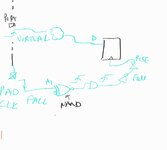Qwerty112233
Member level 2
When we have let's say, NAND gate on clock path..does that change timing edges and checks for setup and hold?
Seeing a rise edge flop that is getting timed at falling edge for hold..but it shows NAND cell in the path so i'm curious how these non buffer/inverter clock logic cells change timing?
Seeing a rise edge flop that is getting timed at falling edge for hold..but it shows NAND cell in the path so i'm curious how these non buffer/inverter clock logic cells change timing?
